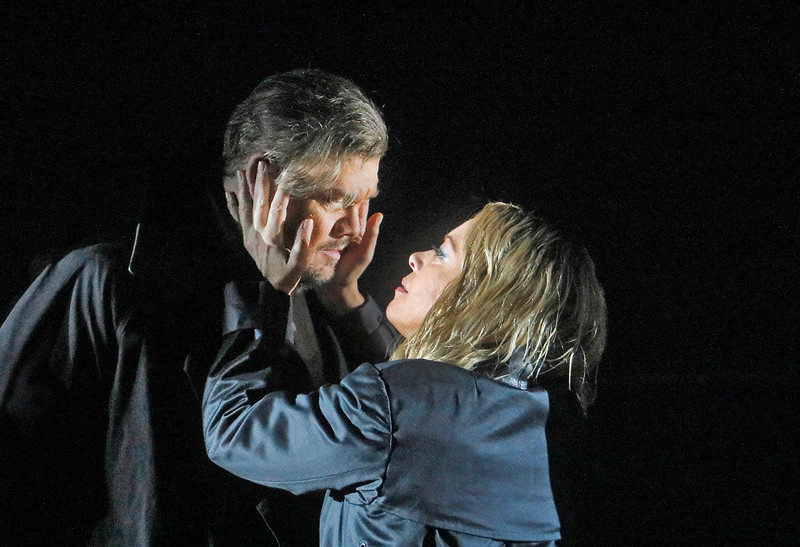Reviews
Met's New Tristan: Sir Simon Is the Star
NEW YORK--First the good news. The Metropolitan Opera opened its new season on Monday (September 26) with a new production of Tristan und Isolde that was stronger musically than any performance of Wagner’s music drama the house has heard in decades. Yes, there have been stellar individual performances but not the winning combination of a great conductor plus two singers capable of meeting the demands of the title roles to such a satisfying a degree.
The star of the evening was Simon Rattle, who led an inspired, beautifully played account of the score. He seemed to look for and find meaning in virtually every phrase of the score in a reading that was never at a loss for energy, even in the most languid or ruminative passages. The prelude, for instance, was on the slow side but built purposefully and organically to its climax, then tapered back just as convincingly. He took advantage of the cast’s strong voices to allow the orchestra to resound robustly while never letting balances to be skewed. Met audiences have heard fine performances from James Levine and Daniel Barenboim, but Rattle’s was more finely detailed than Levine’s and more structured than Barenboim’s.
Nina Stemme has been the world’s Isolde of choice ever since she triumphed in the role at Glyndebourne in 2003, so her role debut in New York was long overdue but by no means comes too late. She sang with full, sumptuously rounded tone without allowing her big voice to sound inert. The narrative and curse in Act 1 had ample temperament, thanks to her vivid projection of text. Isolde’s Transfiguration (popularly known as the Liebestod) was sung with a gorgeous sense of line. Occasionally, one missed Nilsson’s clarion steeliness, but Stemme’s high C’s were spot on, and for one of them Rattle rightly slowed the tempo a touch to let it register.
 Stuart Skelton as Tristan, Nina Stemme as Isolde
Stuart Skelton as Tristan, Nina Stemme as Isolde
As Tristan, Stuart Skelton also demonstrated a striking ability to sing lyrically, as in leading off the final section of the Act 2 love duet, which makes use of the melody later heard in the Transfiguration. (Earlier the big traditional cut in the duet’s first section, unfortunately, was observed.) Skelton had power for big moments, but it’s the lyricism as well as the capacity for expression in the delirious utterances of Act 3 that define a great Tristan, and Skelton delivered, even if his voice sounded a little raw late in the evening.
Ekaterina Gubanova’s superbly sung Brangäne came as a highly pleasant surprise. Evgeny Nikitin offered a stalwart, handsomely sung Kurvenal, and René Pape reprised his familiar, highly polished King Marke. Neal Cooper and Alex Richardson made noteworthy Met debuts as Melot and a Shepherd.
The less than good news is not all that bad. Mariusz Trelinski’s production suffers from an excessively dark stage (Marc Heinz is the lighting designer) and an overemphasis of a nautical motif. The darkness was particularly troublesome in Act 1, as was the placement of singers in rectangular boxes within Boris Kudlicka’s set depicting a cross-section of the ship bearing Isolde to her would-be husband, King Marke. The act lacked dramatic punch.
Shortly after the start of the Prelude, a circular radar screen was projected onto a drop curtain, as were images of ships in turbulent seas; later, pictures appear of a man in uniform and a boy, whom we infer are Tristan and his father, who died early in Tristan’s life. Tiresomely, each of the successive acts begins similarly.
Clearly, Trelinsky sees Tristan as a man scarred in childhood by the loss of his parents (his mother died in giving him birth). Now and again this Tristan imagines visions of a man in a white sailor’s suit, suggesting both that he longs for his lost father and that he regards King Marke (who is similarly attired in Marek Heinz’s costumes) as a father figure.
Some aspects are difficult to figure out, such as Tristan’s apparent re-experiencing of his slaying of Isolde’s betrothed Morold as an act of cold-blooded murder. But the upside is that Trelinski doesn’t slap on his interpretation heavy handedly. Moreover, his direction of the principals is sure—these lovers know how to hug each other.
Then too, things improve once past the cramped setting of Act 1, although one can imagine a more romantic locale for the love duet—Wagner’s specified garden setting, for starters—than the hold of the ubiquitous ship. And the hospital setting of Act 3 works perfectly. The opera ends with a fine stroke of theater as Tristan is seen sitting stationary in his uniform while Isolde sings the Transfiguration apparently for his benefit alone. It allows the audience to depart feeling the effects of a memorably induced Wagner high.

WHO'S BLOGGING

Law and Disorder by GG Arts Law
Career Advice by Legendary Manager Edna Landau
An American in Paris by Frank Cadenhead





 FEATURED JOBS
FEATURED JOBS

 RENT A PHOTO
RENT A PHOTO


